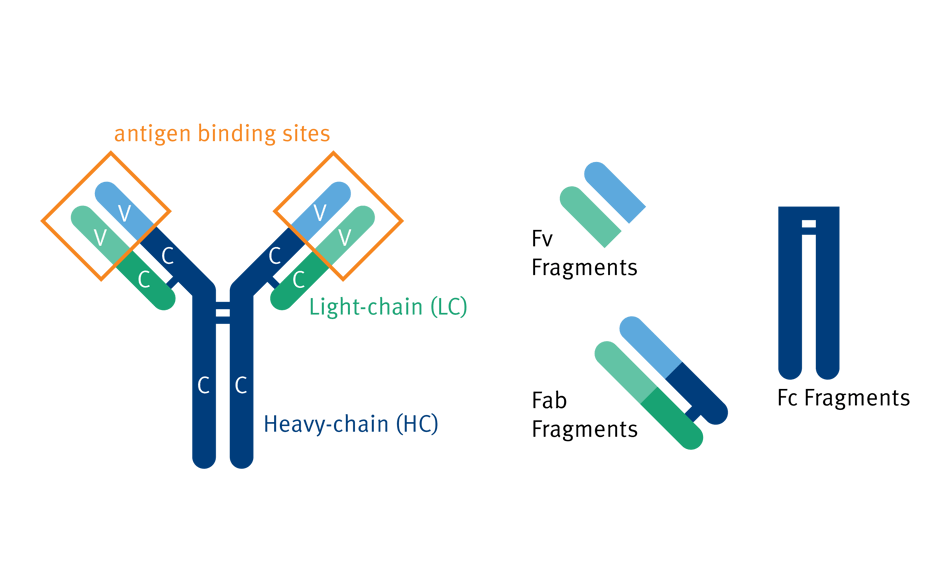Purification of immunoglobulins is essential for the development of new biopharmaceuticals and affinity chromatography is a popular method for this application. One approach to purification of immunoglobulins it to employ histidine tags, which make binding to metal ions stronger and therefore chromatographic purification more efficient. However, when working with antibodies that are expressed without such a tag, affinity medias with immobilized ligands with binding affinity to specific regions of the antibody can be used for chromatographic purification. In these instances, it is important to consider the structure of the antibody, for example there is often considerable variation in the strength of interactions of specific affinity resins to the same antibody when it is derived from different animal sources. This blog post gives an overview of the structure of antibodies and which affinity medias can be used for purification of different types of immunoglobulins.
Antibody Structure
Antibodies consist of four polypeptide chains – two identical heavy chains and two identical light chains. The different polypeptide chains are held together by disulfide bonds. The flexible region where the two heavy chains are joined is referred to as the hinge. Both the heavy and light chains consist of different regions called the constant (C) and variable (V) domains. The variable domains of the heavy and light chains together form two identical antigen binding sites. The genes that code for each polypeptide chain and their corresponding structure enable the production of extremely vast number of antibodies exhibiting different antigen binding site for the immune response in the body.
There are five different antibody sub classes - IgG, IgM, IgA, IgE and IgD. Each antibody class differs in the structure of the heavy chains and therefore exhibit different effector functions. IgG and IgA immunoglobins can also be further classified into subclasses, with further minor variations in the heavy chain between the different subtypes.
IgG purification by Protein A and Protein G
Of the five antibody classes, IgG is the most abundant in human serum. Protein A and Protein G are bacterial derived surface proteins that demonstrate a natural binding affinity to the Fc region of IgG antibodies. Accordingly, Protein A and Protein G affinity medias can be used for purification of IgG fragments that include the Fc region. Furthermore, Protein A and Protein G bind to various antibody subclasses with different binding affinities. So, even though Protein A is by far the most common affinity resin for purification of IgGs, protein G is preferable when it comes to certain subtypes, such as rat IgG2a.
Learn more about affinity medias and purification of IgGs in this application note: ProPlus PhyTip Affinity Columns – The Antibody Purification System that is the Best of Protein A and Protein G

Purification of Antibody Fragments
The immunoglobin light chains exist in two different types – lambda (λ) and kappa (κ). In human antibodies, these chains are about as commonly found, but in mouse antibodies, the kappa light chains are dominant.
Purifying antibody fragments is also of increasing interest in biotherapeutics. Advancements in antibody cloning technologies have led to the ability to express antibody fragments – antibodies that include truncated forms of antibody chains with specific properties, such as Fab fragments, Fv fragments and Fc fragments. For purification of antibodies that include a Fc region, Protein A and Protein G can be used as discussed previously, but for antibody fragments lacking the Fc-region, affinity medias with ligands with the ability to bind to other parts of the antibody is required. This is typically to the lambda and kappa light chain. An example of such medias are the Protein L affinity medias that bind to the variable region of the kappa light chain or the CaptureSelect™ affinity medias that are available with specific binding to various polypeptide chains. The CaptureSelect™ affinity medias contain immobilized antibody fragments to serve as affinity ligands that can be adapted for different proteins, antibody fragments and viral vectors.
Learn more about purification of antibodies by binding to the Fc region and kappa light chains of human IgGs: PhyTip Columns Containing CaptureSelect™ Resins for Purification of Antibodies and Antibody Fragments

 Organic Workflow
Organic Workflow Peptide Workflow
Peptide Workflow Scale-Up Flash Purification
Scale-Up Flash Purification  Sample Preparation
Sample Preparation Biomolecule Purification
Biomolecule Purification Oligo synthesis
Oligo synthesis Scavengers and Reagents
Scavengers and Reagents Service & Support
Service & Support Accessories & Spare parts
Accessories & Spare parts Investors
Investors Reports & News
Reports & News The Share
The Share Corporate Governance
Corporate Governance Calendar
Calendar Sustainability
Sustainability Our Offering
Our Offering Our History
Our History Our Locations
Our Locations Leadership
Leadership